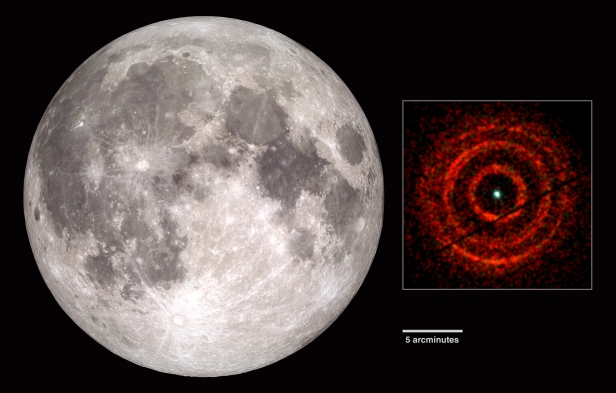A team of astronomers led by Andrew Beardmore at the University of Leicester, U.K. have captured rings of X-ray light (resembling a shooting target) resulted due to black hole explosion in the centre of V404 Cygni, using the X-ray Telescope aboard NASA’s Swift satellite.
The team includes scientists from the Southampton, and Oxford in the U.K., the University of Alberta in Canada, and the European Space Agency in Spain.
V404 Cygni is a binary star system situated in the constellation Cygnus, which once had either late G or early K companion star revolving around each other under their mutual gravitation. It consists of erupting black hole with a mass of about 12±3 solar masses.
As you can see, a series of concentric rings which astronomers say are resulted from an “echo” of X-ray light, extends about one-third the apparent size of a full moon.
A narrow gap splits the middle ring in two and each color represents the energy of x-rays. Red ring represents the lowest energy which ranges from 800 – 1,500 eV electron volts, green for medium, ranging from 1,500 to 2,500 eV, and blue as the most energetic 2,500 to 5,000 eV.
According to the astronomers, the black hole’s flares emit X-rays in all directions. Dust layers reflect some of these X-rays back to us, but the light travels a longer distance and reaches us slightly later than light traveling a more direct path. The time delay creates the light echo, forming rings that expand with time. These rings originate from a big outburst that occurred on June 26 at 1:40 p.m. EDT and these multiple rings are caused by multiple reflecting dust layers between 4,000 and 7,000 light-years away from our solar system.
“The flexible planning of Swift observations has given us the best dust-scattered X-ray ring images ever seen,” Beardmore said.
V404 Cygni was first discovered on May 22, 1989 by the Japanese Ginga Team and in 2009, the black hole at the centre of it became the first black hole to have an accurate parallax measurement for its distance from our solar system measuring 8000 light-years.
Its previous eruption ended in 1989 and the first signs of its renewed activity was detected on 15 June, 2015 by NASA’s Swift satellite. Its activity of flaring up of high-energy light happens every couple of decades and whenever this happens, V404 Cygni becomes fifty times brighter than the Crab Nebula making it the brightest object in the X-ray sky. Other outbursts, which astronomers probably didn’t notice, occurred in 1938 and 1956.
Keeping track of these rings and how they change as the eruption continues will allow astronomers to better understand their nature and the detailed study of the normally invisible interstellar dust in the direction of this black hole can be done. [Hat Tip: NASA, Andrew Beardmore (Univ. of Leicester) and NASA/Swift]



So cool!
LikeLike
Thanks, Mitch. 🙂
LikeLike
Amazing technology, how do they photograph the black hole and it’s really interesting to know.
LikeLike
Well they used X-ray. Amazing indeed. 🙂
LikeLike